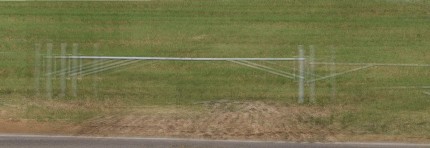Futurism Meet Motion Blur
To construct a narrative concerning the development of land use areas and encroachment within the Louisiana landscape, I conducted a study to connect these spaces through movement using stationary images. The narrative begins with a study of twentieth century futurist paintings and sculptures as references for creating movement of a still object, a fence. The second study examines using the moving fence, to connect spaces of a triptych.
A fence segment is the inspirational infrastructure used to link differing land use areas. All fences consist of multiple, singular sections bound together establishing a linear barrier. With repetition, placement, and opacity fluctuations it is possible to capture movement in a solitary object. This digital process combination relates to the analogue contributions from Italian, Futurist artists (1909-1916). Futurism explored the visualization of speed with relation to the developing modern world. The repetition in futurist artworks reflects industrial monotony, the cultivation of the assembly line, man/nature as a machine and the endless expanse of a metropolitan society. The period embraces the progressions of new technologies and their rapid incorporation into society through repetition, simulating movement.
The fence study (fig.1) is constructed in Photoshop by repeating the same image at different opacities, followed by a layering technique to replicate movement. The spacing and overlaying produce a blurring effect, indicating this movement.
The second study (fig.2) elaborates on the moving fence concept. In the triptych, the fence is used as a constant to lead the viewer through the spaces. The three areas rural, residential and industrial exhibit encroachment. Each land use meanders into the opposing spread, highlighting the increasingly blurred, zoning lines as urban sprawl expands. The construction of the triptych, while inspired by futurism, focuses on capturing the essence of digital photography’s motion blur techniques. Normally, using a long exposure time or adjusting apertures etc., would capture the essence through a camera lens, however it became more apparent through the digital creation process to use repetition/opacity/placement effects as a means to carry time. The fence became a repeated cutout (excluding the original image’s background), sturdier than the blurred images of the first study. The land use areas developed into spaces consisting of more movement by elaborating each sectors focus (live oak, homes, and factories). Using the techniques described above, the three land use areas evolved into predictions of growth over an extended period of time.
fig.1
fig.2


